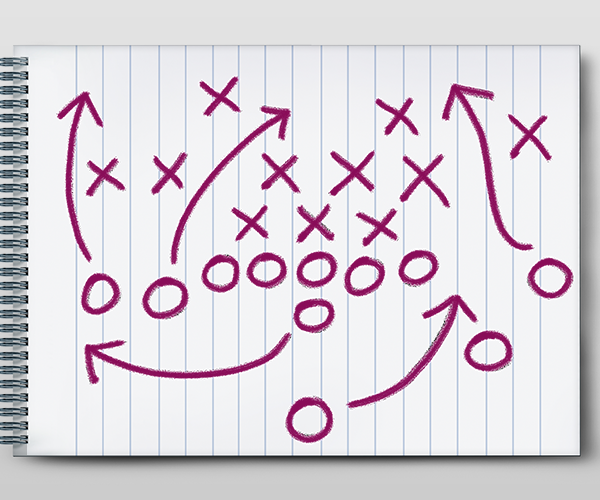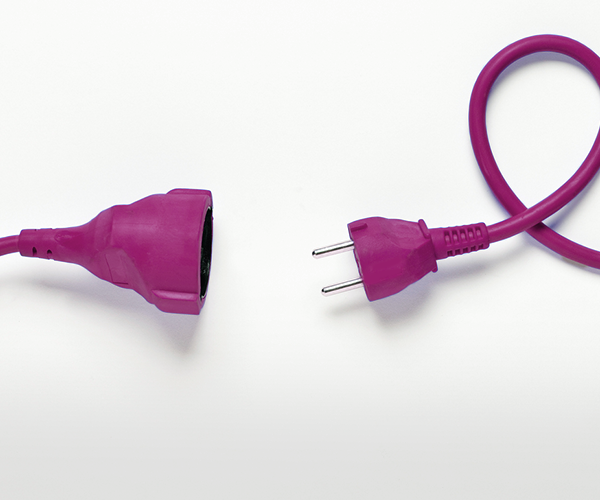Market Ethos
September 16, 2024
Where to next?
Sign up here to receive the Market Ethos by email.
Summary: Cash yields are starting to come down as central banks cut short-term rates. Will the trillions that flowed into cash over the past couple years start to look elsewhere for better returns? We think so, but it also really depends on where that money originally came from.
Ok, we all watched this play out over the past few years: as cash yields rose, the money started flowing. And did it ever. Billions and trillions flowed into various cash vehicles from GICs, HISAs, and money market funds. A special thanks must be given to ‘inflation’ which returned in a big way, resulting in the central bank response to aggressively hike overnight rates. The result: cash yields quickly became rather alluring.
In the U.S., money market balances increased from $4.5 to over $6 trillion over the past year and a half. Similar trends were evident in Canada, adjusted for proportionate population/wealth. This leads to the multi-trillion dollar question: as yields are now coming down, what will this money do?
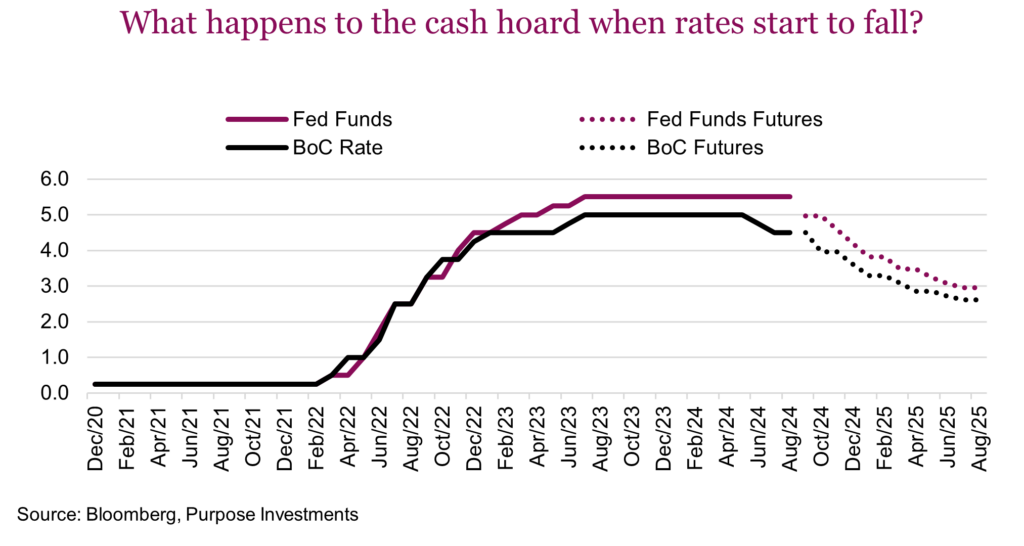
The Bank of Canada has started cutting and the U.S. Fed appears to be on the cusp. Of course, the future path of rates remains uncertain, but the trajectory is not – it’s down. Inflation and economic activity have cooled, so rate cuts are near a certainty. The speed and magnitude are the unknowns based on the data and expectations at this time. And that means those juicy cash yields will start to come down.
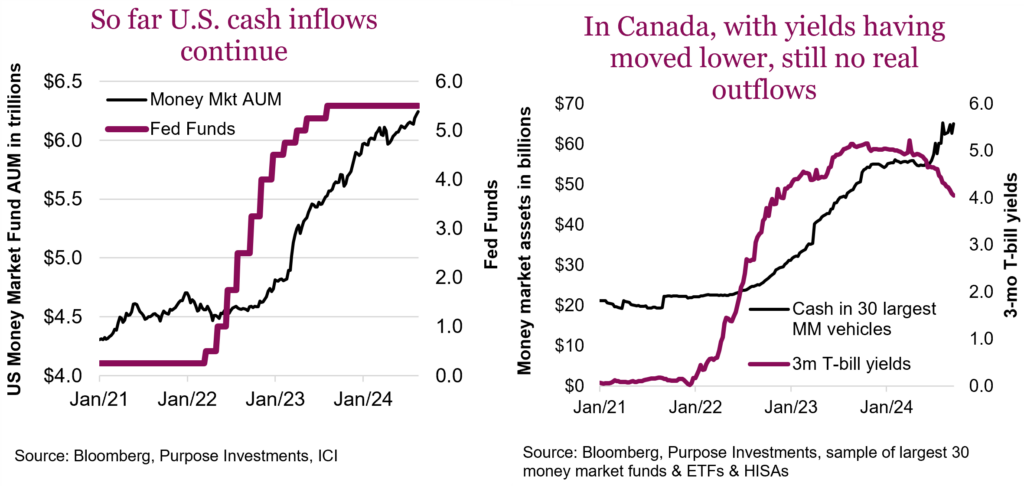
Even with expectations that U.S. short term cash rates are set to start coming down, inflows into U.S. money market funds continues. More impressively, Canada has cut rates a few times already and flows into Canadian cash vehicles have remained positive. The chart below compares apples and oranges between Canada and the U.S., so don’t pay attention to the dollar levels. The U.S. is ICI data of money market funds, while the Canadian chart is simply the 30 largest cash vehicles. The take-away from the chart is the trajectory of cash balances – the black lines, going up, stable or going down. So far still rising, albeit at a slower pace.
Line in the sand
As yields available in cash vehicles come down, is there a line in the sand that will see inflows slow or even start to exit? As it was high yields that enticed the inflows, if they fall down to 4% or 3.5% or even 3.0%, will we start to see outflows? And where will that money go? We believe it really depends on where the money originally came from that could dictate its next destination.
Chequing accounts and account sweeps – A sizeable amount of money that has gone into cash vehicles came from traditional chequing or bank accounts. It was an easy decision as chequing accounts were paying much less than the yield available in cash vehicles. Many folks moved the excess chequing account balance to an investment account to buy a cash product and pick up that extra yield. This money is unlikely to move into more risky assets even as yields move lower. It simply isn’t risk capital. Maybe it just stays, earns less, or maybe some even moves back to chequing accounts if the spread in yield narrows enough.
Some of the money that went into cash vehicles was the small cash balance in portfolios. Perhaps the portfolio holds 1-3% cash to handle cash flow or expense requirements. When yields rose it made sense to sweep these cash balances into a vehicle that would pay more. So even if yields fall, this money is unlikely to move as it is required for liquidity purposes.
Parking in cash – A portion of these huge cash vehicle balances has been parked in cash because investors didn’t want to deploy into riskier investments. Fear of a market pullback, either equity or bond, combined with the attractive safe yield in cash caused many to allocate more to cash. If cash yields get too low this money could very well start looking for better returns or yields elsewhere.
This could result in sizeable inflows to bonds across the credit and maturity spectrum. And it could also result in strong flows for dividend paying companies. Many portfolios remain light on duration after the experience of 2022. Given the slowing of economic growth turning into a bigger risk than inflation, this may entice some of this money into longer maturities.
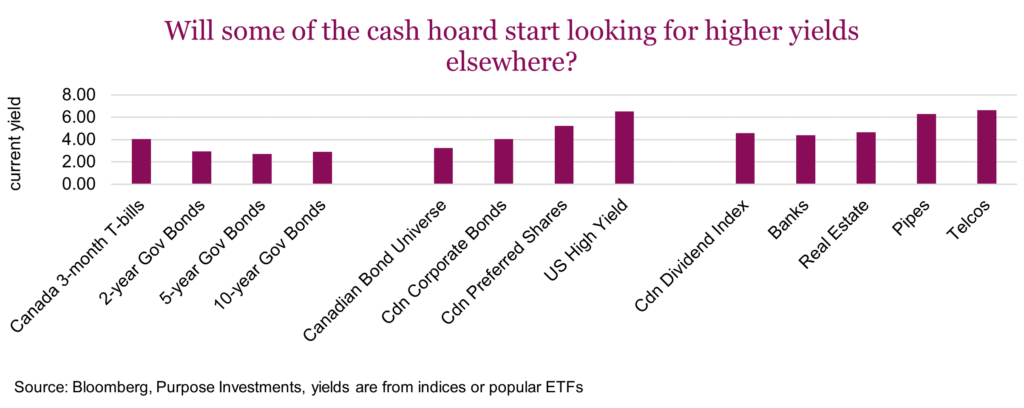
The dividend space has enjoyed a strong rebound over the past couple months. The dividend factor has suffered over the past couple years because it’s a higher yield environment. There were simply many other choices to pick up yield, with less risk than dividend equities. But with cash yields falling, the attractiveness of dividends is starting to become much more compelling (albeit with more risk than cash, better taxation and growth potential – a lot more variables).
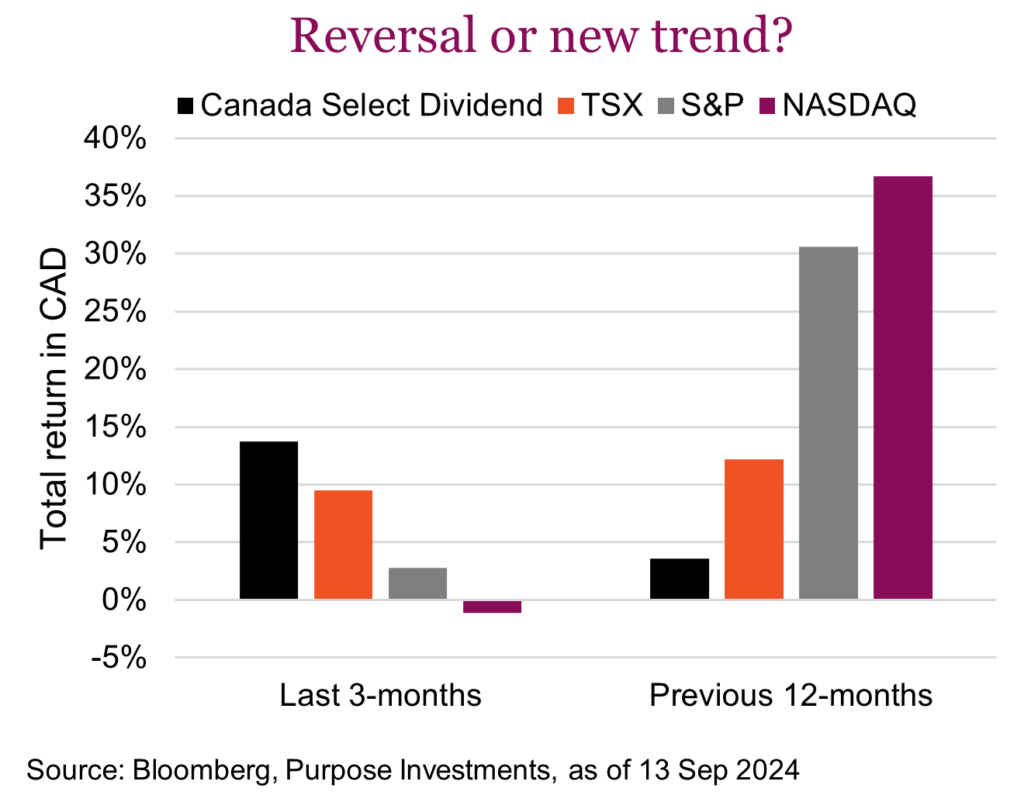
Telcos and pipelines yielding 6-7% might not be compelling enough compared to cash at 4.5%. But what if cash yielded 4% or 3%? It is worth pointing out that over the past 3-months the DJ Canadian Dividend Select index has returned 13.5% compared to 9.6% for the broader TSX, 2.9% for the S&P and -1% for the Nasdaq; a clear reversal of the previous year.
Given dollars don’t appear to be flowing out of cash vehicles just yet, this reversal has been more driven by falling bond yields lifting dividend stocks out of the basement. This could just be a short-term counter trend rally or if yields have truly changed directions, this catchup may have a lot of room to run.
Final thoughts
If you believe the cash allocation ‘call’ has nearly peaked, its reversal will likely see healthy flows into a number of areas of the market, including dividend-paying companies. Even if cash vehicles don’t see big outflows, a lack of inflows would mean there is more money going back to normal bonds, dividends and other sources of income available in the market. More importantly, if this trend takes hold it could have a long way to run looking at how far previous flows went in other direction.

